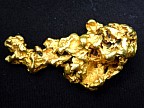Detecting in areas where dredges have worked in the past
2 posters
Page 1 of 1
 Detecting in areas where dredges have worked in the past
Detecting in areas where dredges have worked in the past
Has anyone had any experience around the Araluan/Jembaicumbene area where the big dredges used to work ? As I understand it the dredges floated their way on the river flats and paddocks and dug down to bedrock filling in behind themselves with the tailings. So they basically turned the land upside down. What are the views on the detectability of areas like this?
In an area fronting Jembaicumbene Creek near Braidwood in NSW that I have looked at recently there are many granite boulders and outcrops up the slope from the river flat. They are evident in a series of rolling hills down to the river flat. The dirt around these is sandy but with clay and can be pretty hard once you get through the grass. I’ve also found lumps of quartz, size of a double fist, in between the boulders, but it is not usually visible on the surface. It seems many of the areas around these boulders have been worked as there is a lot of evidence of races and the odd collection of rocks that does not look natural. Plus what look like test holes. Some of the gullies are very soft and boggy. There is virtually no trees as it has all been cleared at some point for grazing. But the grass is pretty thick making it hard to get coil near the ground. Targets recovered are bullet casings and .22 slugs, scraps of wire and tin. My strategy so far has been to stick with the 11inch and look around the boulder outcrops paying special attention to areas that may have been worked. Checking the bottom and sides of what look like sluice gullies and some random swinging on the slopes between these. However with about 200 hectares at my disposal I need to refine searching techniques otherwise I will die of old age before I finish..
The questions that arise in my mind are:
a/ does the activity of dredges mean the soil is really too deep for detecting on the flats areas? How much might they have missed.
b/ if the dredges were working the bottom of the creek, does this mean there may be gold amongst the granite boulders and outcrops? Most of those by the way are rounded, so may indicate some ancient seabed. There’s a lot of them and they are over a large area.
c/ To my mind the recorded yields of the dredges (see below extract from Minfacts History.) was not large (apart from the Redbank) considering the volume of material that went through them. I can’t find any records about nuggets, nor if the gold was coarse or fine.
Production of gold from the dredges in the Araluen Mining Division was 6 673kg (214 568oz) according to Registrars Returns.
Of this figure, about 5 662kg was won from the Araluen Valley and 1 011kg from Jembaicumbene Creek.
The main activity took place between 1900-1924, with minor production between 1935-1942.
Where full statistics are given for the Araluen division, 5 809kg (186 784oz) were won from 35 000 000m3, representing an average grade of 0.16g/m3.
In the Araluen Creek Valley a strip of ground 5km long averaging 600m wide was worked, the depth probably averaging about 9m, bottoming on granite and metasediments.
It would appear that of the order of 75% of the ground had been previously worked over before dredging commenced.
In the new ground, the clayey nature of much of the overburden greatly hindered progress, as well as the frequent large granite boulders in the wash.
Old logs and timbers from old workings were also frequently met with, making regular repairs and overhauls of the equipment necessary.
The principal producer was the Araluen Redbank Company, which won 904kg @ 165 g/m3 between 1905-1924, using one or two bucket dredges.
The Victorian Araluen Dredging Co., working between 1911-1920, recovered 475.6kg from 3 479 000m3 (0.13g/m3) using a steel hulled 0.2m3 bucket dredge.
Tewksbury Proprietary Dredges N.L., using two 0.2m3 bucket dredges, recovered 595kg from 4 156 900m3 (0.133 g/m3) between 1912-1919.
Up to nine dredges were working simultaneously at Araluen (1905), however individual production figures are largely incomplete.
In an area fronting Jembaicumbene Creek near Braidwood in NSW that I have looked at recently there are many granite boulders and outcrops up the slope from the river flat. They are evident in a series of rolling hills down to the river flat. The dirt around these is sandy but with clay and can be pretty hard once you get through the grass. I’ve also found lumps of quartz, size of a double fist, in between the boulders, but it is not usually visible on the surface. It seems many of the areas around these boulders have been worked as there is a lot of evidence of races and the odd collection of rocks that does not look natural. Plus what look like test holes. Some of the gullies are very soft and boggy. There is virtually no trees as it has all been cleared at some point for grazing. But the grass is pretty thick making it hard to get coil near the ground. Targets recovered are bullet casings and .22 slugs, scraps of wire and tin. My strategy so far has been to stick with the 11inch and look around the boulder outcrops paying special attention to areas that may have been worked. Checking the bottom and sides of what look like sluice gullies and some random swinging on the slopes between these. However with about 200 hectares at my disposal I need to refine searching techniques otherwise I will die of old age before I finish..
The questions that arise in my mind are:
a/ does the activity of dredges mean the soil is really too deep for detecting on the flats areas? How much might they have missed.
b/ if the dredges were working the bottom of the creek, does this mean there may be gold amongst the granite boulders and outcrops? Most of those by the way are rounded, so may indicate some ancient seabed. There’s a lot of them and they are over a large area.
c/ To my mind the recorded yields of the dredges (see below extract from Minfacts History.) was not large (apart from the Redbank) considering the volume of material that went through them. I can’t find any records about nuggets, nor if the gold was coarse or fine.
Production of gold from the dredges in the Araluen Mining Division was 6 673kg (214 568oz) according to Registrars Returns.
Of this figure, about 5 662kg was won from the Araluen Valley and 1 011kg from Jembaicumbene Creek.
The main activity took place between 1900-1924, with minor production between 1935-1942.
Where full statistics are given for the Araluen division, 5 809kg (186 784oz) were won from 35 000 000m3, representing an average grade of 0.16g/m3.
In the Araluen Creek Valley a strip of ground 5km long averaging 600m wide was worked, the depth probably averaging about 9m, bottoming on granite and metasediments.
It would appear that of the order of 75% of the ground had been previously worked over before dredging commenced.
In the new ground, the clayey nature of much of the overburden greatly hindered progress, as well as the frequent large granite boulders in the wash.
Old logs and timbers from old workings were also frequently met with, making regular repairs and overhauls of the equipment necessary.
The principal producer was the Araluen Redbank Company, which won 904kg @ 165 g/m3 between 1905-1924, using one or two bucket dredges.
The Victorian Araluen Dredging Co., working between 1911-1920, recovered 475.6kg from 3 479 000m3 (0.13g/m3) using a steel hulled 0.2m3 bucket dredge.
Tewksbury Proprietary Dredges N.L., using two 0.2m3 bucket dredges, recovered 595kg from 4 156 900m3 (0.133 g/m3) between 1912-1919.
Up to nine dredges were working simultaneously at Araluen (1905), however individual production figures are largely incomplete.

Imadogman- Contributor Plus

- Number of posts : 376
Age : 65
Registration date : 2011-04-27
 Re: Detecting in areas where dredges have worked in the past
Re: Detecting in areas where dredges have worked in the past
In the USA it is quite common for detector operators to detect bucket dredge tailings, and with some success!
Moore Creek Alaska springs to mind!
I have not heard of anyone doing it in Australia though? Not to say it does not occur!
Local legend has it that nuggets where seen being discharged with tailings, screened rocks, on a Bucket Dredge that worked at Newstead in Victoria?
Moore Creek Alaska springs to mind!
I have not heard of anyone doing it in Australia though? Not to say it does not occur!
Local legend has it that nuggets where seen being discharged with tailings, screened rocks, on a Bucket Dredge that worked at Newstead in Victoria?
Guest- Guest
 Re: Detecting in areas where dredges have worked in the past
Re: Detecting in areas where dredges have worked in the past
Hi Imadogman. I have done a little detecting on dredge tailings without success but know of someone who found a cricket ball sized waterworn piece of quartz with a few ounces in it. Any of the deeper dredges bucketing up from a river bed will bring up large specimens if they are in the area. Detecting the piles of cobbly/bouldery piles of dredge waste is a rare opportunity to detect rocks from the deep beds of rivers we never would normally be able to get to. As monoloop mentioned the dredges screened off the larger rocks as they were designed to mainly process the finer gold.
Re your other questions, with a larger area i would firstly detect all the shallow ground starting with spots on or close to bedrock and any small erosion or wash gullies. No matter how well an area was worked in the 1800's there always seems to be some gold left wedged in bedrock that they could not see.
Hope to see you in the field sometime in 2012.
Cheers Tributer (Duck)
Re your other questions, with a larger area i would firstly detect all the shallow ground starting with spots on or close to bedrock and any small erosion or wash gullies. No matter how well an area was worked in the 1800's there always seems to be some gold left wedged in bedrock that they could not see.
Hope to see you in the field sometime in 2012.
Cheers Tributer (Duck)

Tributer- Contributor Plus

- Number of posts : 1006
Registration date : 2008-10-27
 Similar topics
Similar topics» Detecting Areas Mt BOPPY, Canbeligo Areas
» Detecting areas
» How much is a gpz7000 really worth?
» Detecting around Bright [Victoria], and surrounding areas.
» Detecting in Queensland... within 50Km of a Regional Center... in certain areas.
» Detecting areas
» How much is a gpz7000 really worth?
» Detecting around Bright [Victoria], and surrounding areas.
» Detecting in Queensland... within 50Km of a Regional Center... in certain areas.
Page 1 of 1
Permissions in this forum:
You cannot reply to topics in this forum